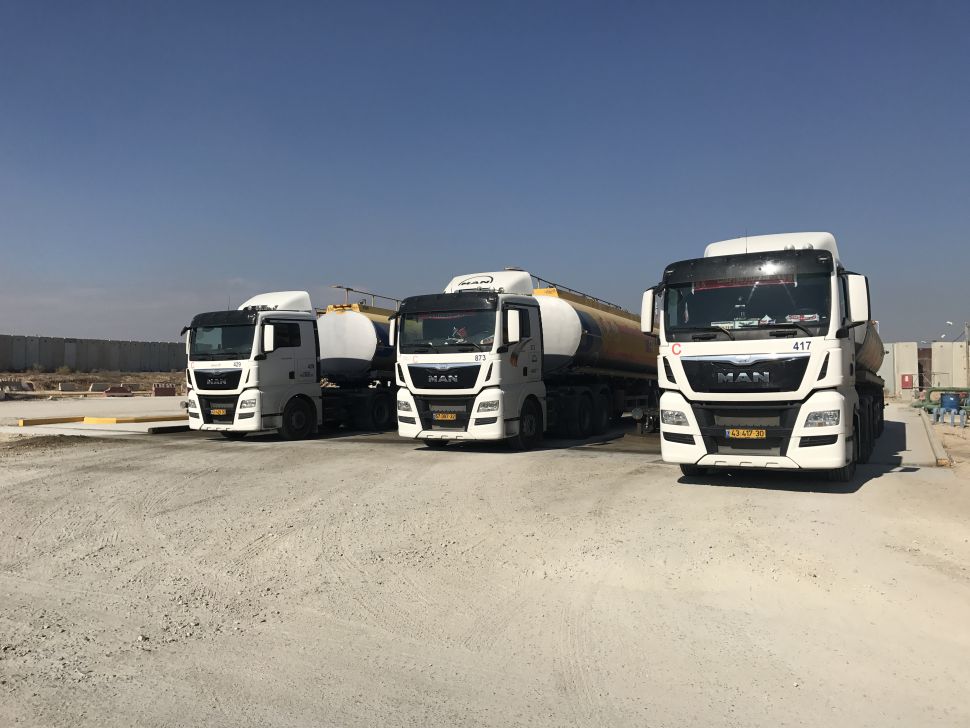In photo: Trucks of fuel wait to enter Gaza from Israel. Credit: Eliana Rudee.
It is projected that as Hamas renews its fight against Israel into 2017, the Israeli Defense Forces will continue to look downward toward tunnels as the terrorist modus operandi, as compared to previous years of looking upward toward rocket fire. In 2017, ISIS operatives will likely continue to be smuggled underground from the Sinai, working with Hamas toward an Islamic emirate that includes Gaza and the Sinai Peninsula. As the people of Gaza suffer under their own corrupt and murderous government, Israel continues to invest millions of dollars into their humanitarian aid of 900 trucks of cargo per day that go through the Kerem Shalom Crossing.
Tunnels
The border between Israel and Gaza has seen relative calm since summer 2014, when Israel discovered and destroyed 33 tunnels that crossed from Gaza to Israel-tunnels created by Hamas to infiltrate Israeli borders and kill its citizens. These 33 tunnels were part of a network of hundreds crossing into Israel and Egypt, kilometers long and wide enough to travel through by motorcycle. The IDF and the Egyptian Army discovered multiple tunnels in 2016, some of them six feet tall and including dining rooms and rest quarters for Hamas operatives. While Israel generates 90 percent of Gaza’s electricity (Egypt has since stopped providing the utility), terror tunnels have 24 hours of electricity per day while homes have only eight. According to IDF spokesperson Captain Libby Weiss, in 2017, these tunnels will likely continue to be Hamas’ capstone project. Priced at $3 million per tunnel, Hamas has spent tens if not hundreds of millions of dollars on the terrorist infrastructure.
Rockets
Hamas has fired between 24 and 27 thousand rockets since 2001-most recently, ISIS has taken credit for Gaza rocket fire. Since the last operation, over 100 rockets were fired by Hamas: 3 percent from military bases and 97 percent from civilian centers such as hospitals, schools, homes U.N. sites and community centers. Because of its close proximity to Gaza, Sderot in southern Israel is known as the “bomb shelter capital of the world” of which over half a billion have been shekels spent on construction, with 6,000 more units planned in the New Year. Also running from Hamas rockets are the 50 Muslim Arabs who have settled in Sderot as Israeli residents after collaborating with the IDF. Into 2017, the IDF and Israeli Air Force are likely to continue to invest in precisely targeting militants despite its operational disadvantages of texting, calling, disseminating leaflets and “knocking on the roof” with empty shells before destroying terrorist infrastructure.
Political Power
According to IDF Captain Weiss, 2016 has seen “50 shades” of radical groups attempting to assert control in the Gaza strip. According to a recent report by Arab journalist Khaled Abu Toameh, several of these groups include factions of the Islamist movement, cooperating with ISIS-affiliated jihadi terrorist groups who were “admitted to the Gaza Strip hospital in return for weapons given to Hamas by the Islamic State in the Sinai.” According to an anonymous operative, the IDF observes Hamas providing supplies, medical aid, information and knowledge to ISIS on a daily basis. Such political conditions smack of increasing Hamas power and decreasing chance of a Palestinian state in 2017. Taxes on Gazans are high, but few shekels are invested back into the Gazan economy. Instead, those funds are advanced toward the construction of terror tunnels.
Humanitarian Aid from Israel
Despite the terrorist threat that the Gaza government poses against Israel, the Jewish State continues to send 1.9 million Gazan citizens humanitarian aid through the Kerem Shalom cargo crossing. According to Ami Shaked, the Ministry of Defense’s General Manager of the crossing who lived in Gaza for 20 years, there have already been 190,000 trucks of humanitarian aid in 2016-up from 153,000 in 2015 and 69,000 in 2014. Shaked meets with seven Palestinian Authority contractors and 75 Palestinians on a daily basis who oversee the transportation of goods into Gaza. Shaked has found over a thousand truckloads of rocket fuel in the last year. Israel continues to send fruits and vegetables, furniture, recycled iron, cement, gas, fuel and textiles to promote Gaza’s infrastructure. However, the Gazan people do not see all of the aid, as Hamas often acquires the material and resells it with a hefty tax. Cement that should cost NIS 500 per ton is resold for NIS 1400 per ton.
With the rise of ISIS in the Sinai, smuggled into Gaza through tunnels, chances for peace decrease despite increasing humanitarian aid from Israel. Although rockets have slowed since Operation Protective Edge, terror tunnels have increased at the expense of the Gazan people, signaling grim political and economic projections into 2017.
Eliana Rudee is a fellow with the news and public policy group Haym Salomon Center. Her bylines have been featured in USA Today, Forbes, New York Daily News and The Hill. Follow @salomoncenter
Article source: http://observer.com/2016/12/the-gaza-border-from-operation-protective-edge-to-2017-projections/#.WFFS_gdLy9U.facebook










